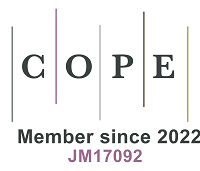REFERENCES
1. Veludo AF, Martins Figueiredo D, Degrendele C, et al. Seasonal variations in air concentrations of 27 organochlorine pesticides (OCPs) and 25 current-use pesticides (CUPs) across three agricultural areas of South Africa. Chemosphere 2022;289:133162.
2. der Veen I, de Boer J. Phosphorus flame retardants: properties, production, environmental occurrence, toxicity and analysis. Chemosphere 2012;88:1119-53.
3. UNEP. The new POPs under the stockholm convention. Available from: http://www.pops.int/TheConvention/ThePOPs/TheNewPOPs/tabid/2511/Default.aspx [Last accessed on 8 Oct 2022].
4. Adebusuyi AT, Sojinu SO, Aleshinloye AO. The prevalence of persistent organic pollutants (POPs) in West Africa - a review. Envir Challenges 2022;7:100486.
5. Fuhrimann S, Wan C, Blouzard E, et al. Pesticide research on environmental and human exposure and risks in sub-saharan africa: a systematic literature review. Int J Environ Res Public Health 2021;19:259.
6. Figueiredo DM, Duyzer J, Huss A, et al. Spatio-temporal variation of outdoor and indoor pesticide air concentrations in homes near agricultural fields. Atmospheric Environ 2021;262:118612.
7. Sarkar S, Dias Bernades Gil J, Keeley J, Mohring N, Jansen K. The use of pesticides in developing countries and their impact on health and the right to food. Available from: https://library.wur.nl/WebQuery/wurpubs/583698 [Last accessed on 8 Oct 2022].
8. Akande MG, Sanni FS, Enefe NG. Human health risk evaluation of organophosphate insecticide residues in post-harvest cowpea in Gwagwalada, Abuja, Nigeria. J Health Pollut 2020;10:1-8.
9. Bbosa T, Tamale Ndagire C, Muzira Mukisa I, Fiaboe KKM, Nakimbugwe D. Nutritional characteristics of selected insects in uganda for use as alternative protein sources in food and feed. J Insect Sci 2019;19:23.
10. Huis A, Oonincx DGAB. The environmental sustainability of insects as food and feed. A review. Agron Sustain Dev 2017:37.
11. Alamu OT, Amao AO, Nwokedi CI, Oke OA, Lawa IO. Diversity and nutritional status of edible insects in Nigeria: a review. Int J Biodivers Conserv 2013;5:215-22.
12. Olum S, Wesana J, Mawadri J, Kizza Nakiranda J, Odongo W. Insects as food: Illuminating the food neophobia and socio-cultural dynamics of insect consumption in Uganda. Int J Trop Insect Sci 2021;41:2175-84.
13. Usman HS, Yusuf AA. Legislation and legal frame work for sustainable edible insects use in Nigeria. Int J Trop Insect Sci 2021;41:2201-9.
14. Meludu NT, Onoja MN. Determinants of edible insects consumption level in Kogi State, Nigeria. J Agr Extens 2018;22:156.
15. Poma G, Yin S, Tang B, Fujii Y, Cuykx M, Covaci A. Occurrence of selected organic contaminants in edible insects and assessment of their chemical safety. Environ Health Perspect 2019;127:1-14.
16. Poma G, Cuykx M, Amato E, Calaprice C, Focant JF, Covaci A. Evaluation of hazardous chemicals in edible insects and insect-based food intended for human consumption. Food Chem Toxicol 2017;100:70-9.
17. Sepuuya G, Kirinya J., Bonabana J., Nakimbugwe D. Estimating the market size of wild harvested raw grasshopper ruspolia differens in Uganda using a supply and demand analysis.
18. Kirunda BE, Fadnes LT, Wamani H, Van den Broeck J, Tylleskär T. Population-based survey of overweight and obesity and the associated factors in peri-urban and rural Eastern Uganda. BMC Public Health 2015;15:1168.
19. Fatunsin OT, Oyeyiola AO, Moshood MO, Akanbi LM, Fadahunsi DE. Dietary risk assessment of organophosphate and carbamate pesticide residues in commonly eaten food crops. Sci Afr 2020;8:e00442.
20. US EPA (Environmental Protection Agency). Regional screening levels (RSLs)-generic tables. Available from: https://www.epa.gov/risk/regional-screening-levels-rsls-generic-tables [Last accessed on 11 Oct 2022].
21. Poma G, Fujii Y, Lievens S, et al. Occurrence, patterns, and sources of hazardous organic chemicals in edible insects and insect-based food from the Japanese market. Food Chem Toxicol 2021;154:112311.
22. European Commission. Chlorpyrifos & chlorpyrifos-methyl. Available from: https://food.ec.europa.eu/plants/pesticides/approval-active-substances/renewal-approval/chlorpyrifos-chlorpyrifos-methyl_en [Last accessed on 8 Oct 2022].
23. US EPA. Chlorpyrifos. Available from: https://www.epa.gov/ingredients-used-pesticide-products/chlorpyrifos [Last accessed on 8 Oct 2022].
24. Ingenbleek L, Verger P, Epiphane Hossou S, et al. Human dietary exposure to chemicals in sub-Saharan Africa: safety assessment through a total diet study. Lancet Planet Health 2020;4:292-300.
25. Musa U, Hati SS, Mustapha A, Magaji G. Dichlorvos concentrations in locally formulated pesticide (Ota-piapia) utilized in northeastern Nigeria. Sci Res Essay 2010;5:49-054.
26. Maran E, Fernández M, Barbieri P, Font G, Ruiz MJ. Effects of four carbamate compounds on antioxidant parameters. Ecotoxicol Environ Saf 2009;72:922-30.
27. US EPA. US EPA - Pesticides - Fact Sheet for Propoxur. Available from: https://www3.epa.gov/pesticides/chem_search/reg_actions/reregistration/fs_PC-047802_1-Aug-97.pdf [Last accessed on 8 Oct 2022]
28. Temitope AO, Job OO, Abiodun AT, Dare AO. Eco-diversity of edible insects of Nigeria and its impact on food security. JBLS 2014;5:175.
29. Sun H, Xu J, Yang S, Liu G, Dai S. Plant uptake of aldicarb from contaminated soil and its enhanced degradation in the rhizosphere. Chemosphere 2004;54:569-74.
30. Zhang X, Karungu S, Cai Q, Yuan Z, Hu X. Effects of propoxur exposure on insecticidal susceptibility and developmental traits in Culex pipiens quinquefasciatus. Insects 2019;10:288.
31. Agwu J, Odo Ejikeme G, Oloto Chiwetalu J, Uwagbae M. Effects of cypermethrin on the biochemical profile of the hemolymph of the African pest grasshopper Zonocerus variegatus (Linn). Int J Biom Sci Engin 2016;3:15-9.
32. Kekeunou S, Tamesse J. Consumption of the variegated grasshopper in Africa: importance and threats. J Insects as Food Feed 2016;2:213-22.
33. Abafe OA, Chokwe T. Determination and dietary risk assessment of neonicotinoid and insect growth regulators in honey. JEEA 2021;1:3.
34. Food Safety Authority (EFSA). Peer review of the pesticide risk assessment for the active substance imidacloprid in light of confirmatory data submitted. EFS2 2016:14.
35. Network of African Science Academies. Neonicotinoid insecticides: use and effects in African agriculture. A review and recommendations to policymakers. Available from: http://hdl.handle.net/20.500.11911/178 [Last accessed on 8 Oct 2022].
36. Hemlock restoration initiative. When to use imidacloprid versus dinotefuran. Available from: https://savehemlocksnc.org/wp-content/uploads/2021/03/Chemical-Product-Comparison-Charts_Oct-2020.pdf [Last accessed on 8 Oct 2022].
37. PAN Europe - Pesticides Action Network Europe. What substances are banned and authorised in the EU market ? Available from: https://www.pan-europe.info/old/Archive/About%20pesticides/Banned%20and%20authorised.htm [Last accessed on 8 Oct 2022].
38. Tesfahun W, Yildiz F. A review on: Response of crops to paclobutrazol application. Cogent Food & Agriculture 2018;4:1525169.
39. Ingenbleek L, Hu R, Pereira LL, et al. Sub-Saharan Africa total diet study in Benin, Cameroon, Mali and Nigeria: pesticides occurrence in foods. Food Chem X 2019;2:100034.
40. Mekonen S, Ambelu A, Spanoghe P. Pesticide residue evaluation in major staple food items of Ethiopia using the QuEChERS method: a case study from the Jimma Zone. Environ Toxicol Chem 2014;33:1294-302.
41. Bempah C, Asomaning1 J, Boateng J, Bempah CK. Market basket survey for some pesticides residues in fruits and vegetables from Ghana. J Microb Biot Food Sci 2012;2:850-71.
42. Codex Alimentarius Commission. Codex pesticides residues in food online database. Available from: https://www.fao.org/fao-who-codexalimentarius/codex-texts/dbs/pestres/en/ [Last accessed on 8 Oct 2022]].
43. US EPA. US EPA - pesticides - fact sheet for dinotefuran. Available from: https://www3.epa.gov/pesticides/chem_search/reg_actions/registration/fs_PC-044312_01-Sep-04.pdf [Last accessed on 8 Oct 2022].
44. US EPA. Reregistration eligibility decision for Ethoprop. Available from: https://archive.epa.gov/pesticides/reregistration/web/pdf/ethoprop_red.pdf [Last accessed on 10 Oct 2022]







